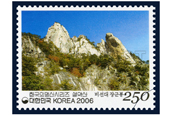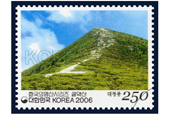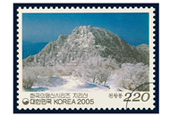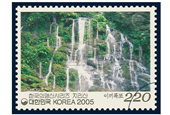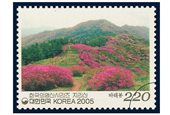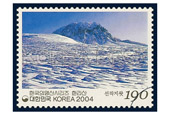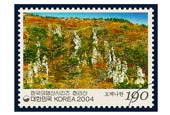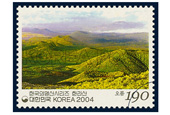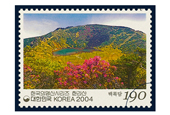-
 Korea.net's 24-hour YouTube channel
Korea.net's 24-hour YouTube channel- NEWS FOCUS
- ABOUT KOREA
- EVENTS
- RESOURCES
- GOVERNMENT
- ABOUT US
Baekdusan Mountain is the highest mountain on the Korean Peninsula, standing 2,750 meters above sea level. The mountain straddles Hamgyeongbuk-do and Hamgyeongnam-do (North and South Hamgyeong provinces) and the North Korea-China border in the northeastern corner of China. The top of the mountain is covered with snow throughout the year and is geologically comprised of white pumice stone. This gave it its name, Baekdu, which literally means, "White Summit."
A variety of animals and plants inhabit the mountain's many climates, depending on the altitude. The mountain was enlisted as a biosphere reserve by UNESCO in 1989 and is protected under related guidelines. It is a sacred mountain for the Korean people and is embedded with their spirit. The pictures of Baekdusan Mountain on the stamps were taken by both North and South Korean photographers and show the magnificent scenery found atop the mountain.
Cheonji, the crater lake atop Baekdusan Mountain, has a circumference of 14.4 kilometers and its surface covers 9.2 square kilometers. The depth of its water is 384 meters at its deepest point and it is 213.3 meters deep on average. The lake is surrounded by dozens of peaks, including Janggunbong, the highest, as well as Hyangdobong and Baekunbong, as if they were a folding screen. The crater lake is located at a high altitude and the surrounding area is inhabited by rare alpine plants, which makes the place scientifically important.
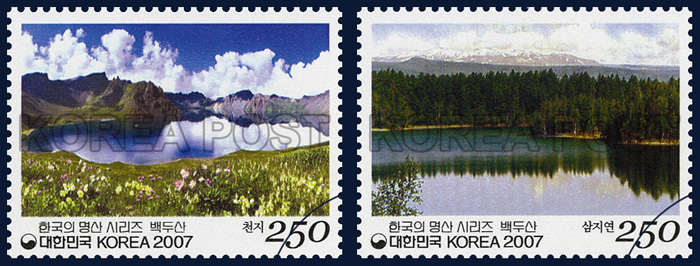
Samjiyeon Lake got its name from the fact that it is comprised of three smaller lakes. Samjiyeon is known to be one of the most beautiful spots at Baekdusan Mountain. The lakes were formed as rivers were blocked due to volcanic explosions. The three lakes are 4.5 kilometers across and the depth in the biggest lake is 1.8 meters on average. The lakes and basalt rock around them create a magnificent view.
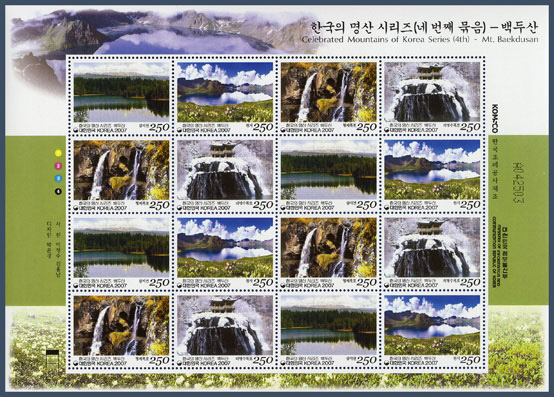
By Limb Jae-un
Korea.net Staff Writer
Photos: Korea Post
jun2@korea.kr
A variety of animals and plants inhabit the mountain's many climates, depending on the altitude. The mountain was enlisted as a biosphere reserve by UNESCO in 1989 and is protected under related guidelines. It is a sacred mountain for the Korean people and is embedded with their spirit. The pictures of Baekdusan Mountain on the stamps were taken by both North and South Korean photographers and show the magnificent scenery found atop the mountain.
Cheonji, the crater lake atop Baekdusan Mountain, has a circumference of 14.4 kilometers and its surface covers 9.2 square kilometers. The depth of its water is 384 meters at its deepest point and it is 213.3 meters deep on average. The lake is surrounded by dozens of peaks, including Janggunbong, the highest, as well as Hyangdobong and Baekunbong, as if they were a folding screen. The crater lake is located at a high altitude and the surrounding area is inhabited by rare alpine plants, which makes the place scientifically important.

The stamps issued in 2007 show the beauty of the crater lake atop Baekdusan Mountain (left) and Samjiyeon Lake.
Samjiyeon Lake got its name from the fact that it is comprised of three smaller lakes. Samjiyeon is known to be one of the most beautiful spots at Baekdusan Mountain. The lakes were formed as rivers were blocked due to volcanic explosions. The three lakes are 4.5 kilometers across and the depth in the biggest lake is 1.8 meters on average. The lakes and basalt rock around them create a magnificent view.

'The fourth set of 'Celebrated Mountains of Korea' stamps shows scenic spots at Baekdusan Mountain.
By Limb Jae-un
Korea.net Staff Writer
Photos: Korea Post
jun2@korea.kr
Related Contents
Most popular
- First hearing-impaired K-pop act hopes for 'barrier-free world'
- Event 'K-Beauty Hang Out' draws hundreds in Philippines
- Ceremony in Seoul inducts 2,641 content creators of Korean culture
- 'Mad Max' director impressed by 'cinema-literate' Korean viewers
- Cultural spring festival Seoul Festa to start on May 1










